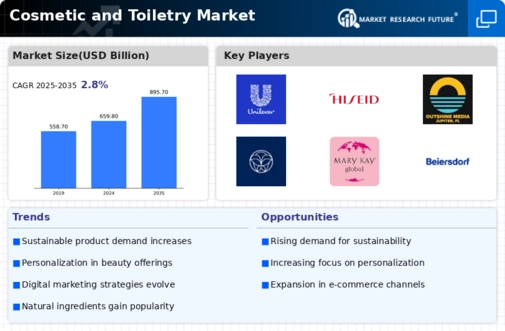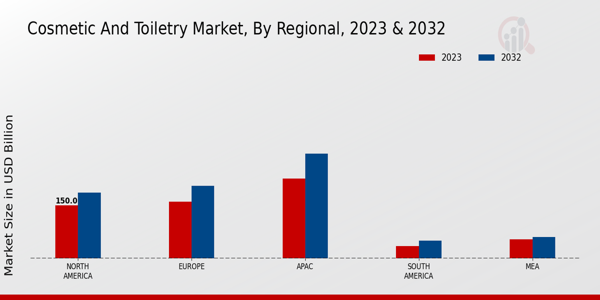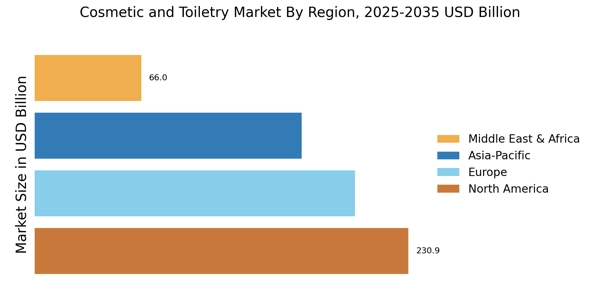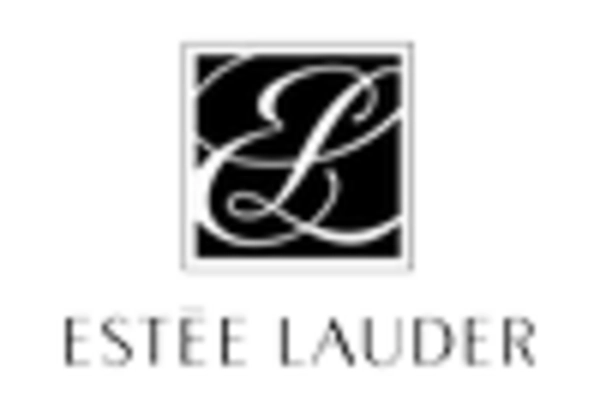Increased Focus on Personalization
Personalization is emerging as a key driver in the Cosmetic and Toiletry Market, as consumers seek products tailored to their individual needs and preferences. Brands are increasingly utilizing data analytics and consumer insights to create customized offerings, ranging from skincare regimens to makeup shades. This trend is particularly relevant in the context of skincare, where consumers are looking for solutions that address specific concerns such as aging, acne, or sensitivity. The ability to provide personalized products not only enhances customer satisfaction but also fosters brand loyalty. Market Research Future suggests that companies that prioritize personalization are likely to see a significant increase in consumer engagement and repeat purchases, thereby solidifying their position in a competitive market.
Rising Demand for Natural Ingredients
The Cosmetic and Toiletry Market is witnessing a pronounced shift towards natural and organic ingredients. Consumers increasingly prioritize products that are free from synthetic chemicals, which has led to a surge in demand for items containing botanical extracts and essential oils. This trend is not merely a passing phase; it reflects a broader societal movement towards health and wellness. According to recent data, the market for natural cosmetics is projected to grow at a compound annual growth rate of approximately 10% over the next five years. This growth is indicative of a consumer base that is becoming more discerning and informed about the ingredients in their personal care products, thereby influencing manufacturers to adapt their formulations accordingly.
Growth of E-commerce and Online Retail
The Cosmetic and Toiletry Market is experiencing a transformative shift due to the rapid growth of e-commerce and online retail platforms. Consumers are increasingly turning to online shopping for convenience and access to a wider range of products. This trend is particularly pronounced among younger consumers who prefer the ease of purchasing cosmetics and toiletries online. Data indicates that e-commerce sales in the beauty sector are expected to account for over 30% of total sales by 2025. This shift not only provides brands with new avenues for reaching consumers but also necessitates a robust digital marketing strategy to engage and retain customers in a highly competitive landscape.
Evolving Consumer Preferences and Trends
The Cosmetic and Toiletry Market is significantly influenced by changing consumer preferences, particularly among younger demographics. Millennials and Generation Z consumers are driving demand for products that align with their values, such as sustainability, ethical sourcing, and inclusivity. This shift is prompting brands to innovate and diversify their product lines to cater to these preferences. For instance, the rise of clean beauty has led to an increase in brands that emphasize transparency in their ingredient sourcing and manufacturing processes. Market data suggests that brands that successfully resonate with these values are likely to experience accelerated growth, as consumers are willing to pay a premium for products that reflect their ethical considerations.
Technological Advancements in Product Development
Technological innovations are reshaping the Cosmetic and Toiletry Market, enabling brands to develop more effective and personalized products. Advances in formulation science, such as the use of nanotechnology and biotechnology, allow for enhanced delivery systems and improved efficacy of active ingredients. Furthermore, the integration of artificial intelligence in product development and marketing strategies is becoming increasingly prevalent. This technology facilitates a deeper understanding of consumer preferences and trends, allowing brands to tailor their offerings more precisely. As a result, companies that leverage these technological advancements are likely to gain a competitive edge, potentially capturing a larger market share in an industry that is projected to reach a valuation of over 800 billion by 2025.



















Leave a Comment